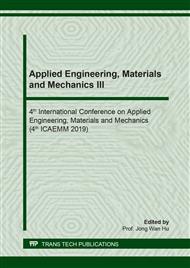[1]
C Liang, H Xiao, Z Hu, X Zhang, J Hu, Uptake, transportation and accumulation of C60 fullerene and heavy metal ions (Cd, Cu and Pb) in rice palnts grown in an agricutural soil, Environ. Pollut. 235 (2018) 330-338.
DOI: 10.1016/j.envpol.2017.12.062
Google Scholar
[2]
Y Dai, Q Sun, W Wang, L Lu, M Liu, J Li, S Yang, Y Sun, K Zhang, J Xu, W Zheng, Z Hu, Y Yang, Y Gao, Y Chen, X Zhang, F Gao, Y Zhang, Utilizations of agricultural waste as adsorbent for the removal of cotaminants: A review, Chemosphere 211 (2018) 235-253.
DOI: 10.1016/j.chemosphere.2018.06.179
Google Scholar
[3]
L. D. Hafshejani, S. B. Nasab, R. M. Gholami, M. Moradzadeh, Z. Izadpanaha, S. B. Hafshejani, A. Bhatnagar, Removal of zinc and lead from aqueous solution by nanostructured cedar leaf ash as biosorbent, J. Mol. Liq. 211 (2015) 448-456.
DOI: 10.1016/j.molliq.2015.07.044
Google Scholar
[4]
I. Safrianti, N. Wahyuni and T.A. Zaharah, Lead adsorption (II) by celullose waste straw rice ctivated nitric acid: effect of pH and contact time, J. JKK, 1(1) (2012) 1-7.
Google Scholar
[5]
F. A. Putri, N. F. Hamadi, A. Y. D. Lestari, A. C. M. Sahid, T. Mutiara, Potential of modified corn cob (Zea mays L.) and petai hull (Parkia hassk) as a new biosorbent for removal of lead waste, KEM, 783 (2018) 126-131.
DOI: 10.4028/www.scientific.net/kem.783.126
Google Scholar
[6]
X. L. Yu, Y. He, Optimal ranges of variables for an effective adsorption of lead (II) by the agricultural waste pomelo (Citrus grandis) peels using Doehlert design, Sci. Rep. 729(8) (2018).
DOI: 10.1038/s41598-018-19227-y
Google Scholar
[7]
G. J. Copello, M. P. Pesenti, M. Raineri, A. M. Mebert, L. L. Piehl, E. R. D. Celis, Polyphenol-SiO2 hybrid biosorbent for heavy metal removal. Yerba mate waste (Ilex paraguariensis) as polyphenol source: kinetics and isotherm studies, Colloids Surf. B: Biointerfaces, 102 (2013) 218-226.
DOI: 10.1016/j.colsurfb.2012.08.015
Google Scholar
[8]
M. K. Mondal, Removalof Pb(II) from aqueous solution by adsorption using actvated tea waste. Korean J. Chem. Eng. 27(1) (2010) 144-151.
DOI: 10.1007/s11814-009-0304-6
Google Scholar
[9]
W. N. L. dos Santosa, D. D. Cavalcante, E. G. P. da Silva, C. F. das Virgens, F. de Souza Dias, Biosorption of Pb(II) and Cd(II) ions by Agave sisalana (sisalv fibr), Microchem. J. 97 (2011) 269-273.
DOI: 10.1016/j.microc.2010.09.014
Google Scholar
[10]
S. R. Shukla, S. P. Roshan, Removal of b(II) from solution using cellulose containing materials. J. Chem. Technol. Biotechnol. 80(2) (2005) 176-183.
DOI: 10.1002/jctb.1176
Google Scholar


